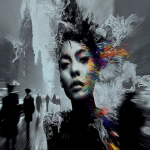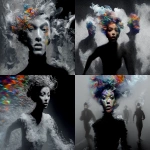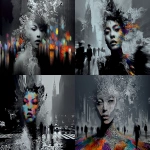Explore the Best AI Image Gallery

Beyond the Canvas: How Wearable Tech is Redefining Creative Expression
The realm of creativity has always been a space of constant evolution, driven by the human desire to express, explore, and innovate. Today, wearable technology stands at the forefront of this evolution, offering artists, designers, and innovators a new set of tools to shape their visions and redefine creative expression.
Wearables as Artistic Instruments
Beyond their practical applications, wearables have emerged as unique artistic instruments. Think of interactive garments that respond to the wearers movements, transforming into flowing patterns or vibrant displays. Imagine gloves that translate hand gestures into musical notes, or headsets that translate emotions into soundscapes. These devices empower artists to transcend traditional mediums and create immersive, interactive experiences.
Sound and Music: A New Era of Sonic Exploration
Music has always been a powerful medium for creative expression. Wearable tech is further amplifying this by providing musicians with new ways to compose, perform, and interact with their audiences. Imagine headphones that allow a musician to hear different layers of a song in real-time, or sensors embedded in an instrument that capture subtle nuances in playing style and translate them into unique soundscapes.
Visual Art: Painting with Light and Motion
Wearables are also revolutionizing visual art. Artists can now use haptic feedback gloves to sculpt digital models, or augmented reality glasses to overlay their creations onto the real world, blurring the lines between physical and virtual spaces. Imagine a wearable device that allows an artist to paint with light itself, creating dazzling displays of color and movement.
Collaboration and Accessibility: Breaking Down Barriers
One of the most exciting aspects of wearable tech is its potential to foster collaboration and accessibility in creative fields. Imagine artists from different locations collaborating on a project in real-time, their creations merging seamlessly through their wearables. Wearables can also empower individuals with disabilities by providing them with new tools for artistic expression and participation.
Ethical Considerations: Navigating the Uncharted Waters
As with any powerful technology, wearable tech raises important ethical considerations. Issues of privacy, data security, and algorithmic bias need to be carefully addressed. Its crucial to ensure that these technologies are used responsibly and ethically, promoting inclusivity and diversity in creative spaces.
Future Trends: Where Will Wearables Take Us?
The future of wearable tech in the creative industry is brimming with possibilities. We can expect to see:
- More seamless integration between physical and digital realms.
- Advanced haptic feedback systems that enhance artistic experiences.
- AI-powered tools that assist artists in their creative processes.
- New forms of wearable art that push the boundaries of expression.
Wearable technology is not merely a tool; its a catalyst for transformation. By embracing its potential while navigating its ethical complexities, we can unlock new dimensions of creative expression and shape a future where art and technology converge to create truly extraordinary experiences.










](https://images.ai-img.art/thumbnails/150/ff09e32d2be011c0dd785984c5c1e47839ce551a31da1bde242860b30df2aa30.webp)



](https://images.ai-img.art/thumbnails/150/847809c77ca9a73b68bc190e6efb06fec87157685a243730d5a66a403b0e6e10.webp)




](https://images.ai-img.art/thumbnails/150/a3ed6513a6661aa3ee46e0c2924d1e8888854e91d8908de39db5590dc41f8d8f.webp)
](https://images.ai-img.art/thumbnails/150/0ba0be922ab76af53f75ab90126ae2b18a600ee3b96941e8ab897a9f10594e5a.webp)

](https://images.ai-img.art/thumbnails/150/2ebdeb4f7db35100e5be5de9bc3e533a40d14e5feedefd7ffc586524a0f3ba8c.webp)
](https://images.ai-img.art/thumbnails/150/bd056a4718c27444e064198762f8dc8ffa1f74f1afd7dcda8d5cb8b142797d6e.webp)



](https://images.ai-img.art/thumbnails/150/7cf5a08238f29c821f52bb4f63db48af0b7f633ff3b9f7253074d78ced9ff6f6.webp)





](https://images.ai-img.art/thumbnails/150/685ae68cfab93a7e59a71206867b060c45bd6fd3cd561c4fe60fca514b09c5f8.webp)















